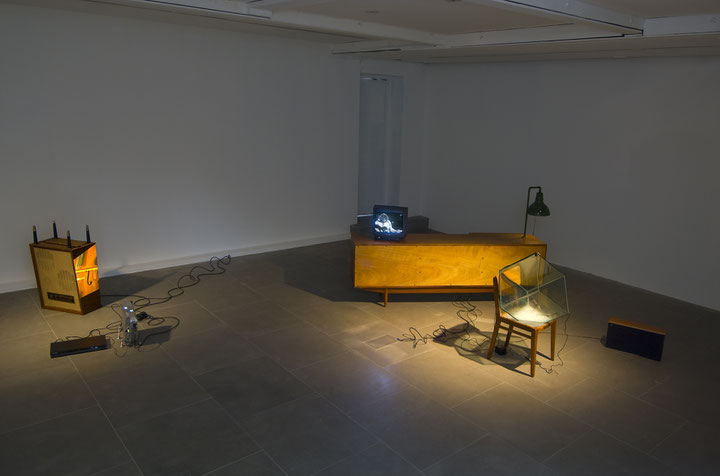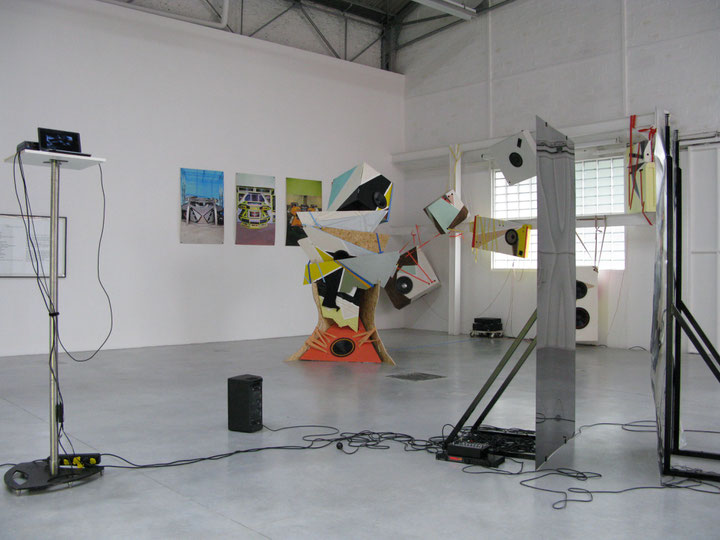Sound art has taken the wrong route, argues Seth Kim-Cohen in his newly-published book »In the Blink of an Ear«1. According to the American theorist, it is trapped in »the dead end of essentialism«2, and just as painting has moved on from Greenberg\'s modernism, it too needs to open up to wider artistic concerns.
Kim-Cohen\'s book develops a number of significant arguments concerning sound\'s status in the art world, but his theories occasionally lag behind practice. Artists such as Robert Rauschenberg and Joseph Beuys were exploring sound\'s extra-sonic implications in the 1960s, and a growing number of artists, curators and critics are pursuing these themes today. The use of sound to address social, political and conceptual concerns is already under way.
These practices typically emphasize sound\'s use value - bypassing the essentialist focus on sound-in-itself. Janet Cardiff and George Bures Miller\'s fascination with audio stems from its capacity to conjure up images in the viewer\'s mind, hence the recurrence of familiar tunes and theatrical sounds in their walks and installations. As Cardiff confirmed in a recent interview: »We are not interested in sound for sound\'s sake - we are interested in what it can do to the audience emotionally, or as an indexical sign. We are image makers, not abstractionists or modernists.«3 Meanwhile, a preoccupation with the »visual« - as opposed to sonic - implications of sound informs British artist Haroon Mirza\'s whimsical mixed media installations. He invests electronic or mechanical sounds with new meaning by associating them with found objects such as pieces of furniture: »I\'m very concerned with objects, their cultural and historic significance and how framing or positioning objects in a particular way is an aesthetic and meaningful endeavour. But if I wasn\'t using these objects to present a sound, I wouldn\'t know what objects to choose« he points out. »There is still a lot to explore with visual material and I\'m interested in how sound can be a catalyst for this.«4
South African artist James Webb, for his part, is finetuning sound\'s capacity to convey ideas hitherto expressed by visuals. One aspect of the problem, as he points out, is that sound is not even spoken about in the same way as sight: »The realm of sight is broken down into all manner of media and traditions. Sound’s very different cultural activities are herded into the same kraal and broken down to their lowest common denominator.«5 Webb handles sound as carefully as he would any other medium: »In order for it to be an effective material, one must understand its nature, history and language,« he notes. »And this goes far beyond an interest in the scientific and demonstrative elements of the medium and its reduced function as music/entertainment, into the realms of its emotional associations, cultural uses and political implications.«6 »Scream« (Guernica) exemplifies his approach. This site-specific intervention consisting of a loud scream emitted in front of Picasso\'s painting Guernica, raises such issues as contemporary history, the horror of war, the function of art and Guernica\'s status as an art icon.
These expanded sonic practices take on an added dimension when viewed through the prism of the history of conceptual art. Drawing a parallel with Duchamp\'s rejection of »retinal« art and its emphasis on the work\'s aesthetic appearance, Kim-Cohen elaborates on the notion of a conceptualized sonic practice: »Since the 1960s, art has emphasized the conceptual [...]. If a non-retinal visual art is liberated to ask questions that the eye alone cannot answer, then a non-cochlear sonic art appeals to exigencies out of earshot.«7 Such exigencies have been the focus in a number of exhibitions in recent years. The exhibition »Claude Closky, 8002 – 9891« (Musée d\'art contemporain du Val-de-Marne, Vitry-sur-Seine, France, 2008) used sound to engage in a critical relationship to the gallery space. This sound-only show transposed fifty-odd predominantly text-based visual works by the French artist into a sonic experience. Visitors wearing headphones heard the texts being read out as they passed through different zones of the vast empty space. Above and beyond the listening experience it provided, sound redefined the space, questioning its use and function. Also out of earshot was the suggestion that technology is transforming the way sound is perceived and understood. Looped and juxtaposed, the spoken texts became increasingly hard to grasp, while the jingle and mobile phone rings that punctuated the listening experience at regular intervals reflected society\'s compulsion to surround itself with sound.
Conceptual art was about the dematerialization of the art object. The curator Daniel Kurjakovic has explored this notion with regard to the sonic arts. He is interested in sound\'s capacity to convey what he calls the »spectral« quality of everyday life - as exemplified by the doubts, stutters, hesitations and silences that occur in day-to-day conversations, expressing presence, but also its opposite, incompleteness and absence. »Our everyday is spectral in so much as we live, very concretely, in an auditive space of unclear sounds«8 he remarks. His radio project »Other Rooms, Other Voices« - a selection of audio works by different artists broadcast on a Swiss radio station in 1999 - explores the »spectrality« that permeates the social and political spheres, pointing at a reality beyond today\'s formatted, ideologically coloured channels of communication and information. In Vittorio Santoro\'s piece, for instance, two voices read out a series of uncontextualized headlines and advertising slogans, exposing their meaninglessness and vacuity and the way they shape our perception of reality. »Sound seems to be a viable way for new curatorial projects where we can deal with conditions of life beyond ideological debate« points out Kurjakovic. »It makes manifest the chorus of ghosts living inside the seeming clarity of political (and other) discourse.«9
Meanwhile, the exhibition »A Listening Room« (Anne + Art projects, Ivry- sur-Seine, France, 2008) ventures into philosophical territory, conveying abstract epistemological considerations through impalpable sonic phenomena. Among the works on show, Inigo Cabo\'s installation Crossover (2008), explores such notions as perception and materiality. Here, the sound spectrum of a conversation occurring on one level of the exhibition space is divided into four and diffused in real time through four directional ultrasonic speakers placed in the four corners of the upper level. When the visitor stands at the crossover point between the speakers, his perceptual system reconstructs the conversation. It has become an evanescent sculptural presence which cannot be heard elsewhere in the space. »Perception mutates and fluctuates« points out curator Manuel Cirauqui. »This is something implicit and subliminal to all aesthetic perception, which »A Listening Room« tried to emphasize and make explicit through sound.«10 For Cirauqui, sound is essentially a means of exploring aesthetic phenomena following a post-structuralist method. Seen from this perspective, the evolution of sound over time can be said to evoke the non-unitary nature of meaning and the impossibility of a definitive interpretation. Far from languishing in the »phenomenological cul-de-sac«11 evoked by Seth Kim-Cohen, sound is up front, clamouring to be heard.
1 Seth Kim-Cohen, In the Blink of an Ear, New York, London: Continuum, 2009
2 Ibid., p.xix
3 Interview with Janet Cardiff by Rahma Khazam, Artpress 2, no. 15, »The Art of Sounds«, November 2009 – January 2010
4 From an e-mail interview with Haroon Mirza, October 2009
5 From an e-mail interview with James Webb, October 2009
6 Ibid.
7 Seth Kim-Cohen, In the Blink of an Ear, op.cit., p.xxi
8 From an e-mail interview with Daniel Kurjakovic, November 2009
9 Ibid.
10 From an e-mail interview with Manuel Cirauqui, October 2009
11 Seth Kim-Cohen, In the Blink of an Ear, op.cit., p.xix

